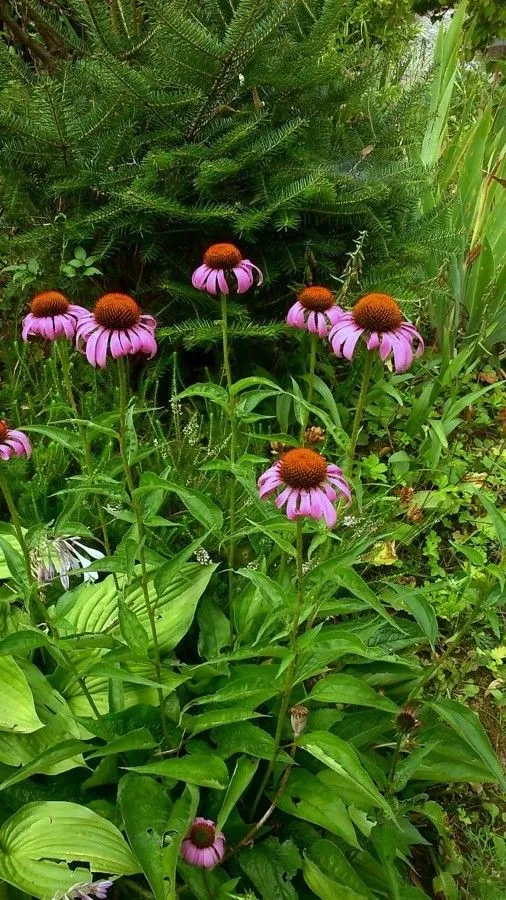
Author: DC.
Bibliography: Prodr. 5: 554 (1836)
Year: 1836
Status: accepted
Rank: species
Genus: Echinacea
Vegetable: False
Observations: W. Canada to N. C. U.S.A.
Black-sampson echinacea, known scientifically as Echinacea angustifolia, is a fascinating perennial plant belonging to the Asteraceae family. First documented in 1836 by the renowned botanist DC., this species has carved out a unique niche in the diverse flora of North America.
Indigenous to Western Canada and the North-Central regions of the United States, Echinacea angustifolia thrives in prairies and open woodlands, where it stands out with its striking appearance. The plant is easily recognizable by its slender, elongated leaves and distinctive flower heads. The blooms typically feature pale pink to purplish petals radiating from a prominent, spiny central cone, which has garnered it the common name “Black-sampson.”
This resilient species adapts well to varying environmental conditions, making it a popular choice for gardens and natural landscaping. Not only is it aesthetically pleasing, but it also plays a vital role in local ecosystems. Echinacea angustifolia attracts a variety of pollinators, including bees and butterflies, thereby supporting biodiversity.
Historically, Black-sampson echinacea has been valued for its medicinal properties. Native American tribes were among the first to utilize its roots and other parts for treating various ailments. Today, it remains a staple in herbal medicine, often used to bolster the immune system and fight off infections.
In summary, Echinacea angustifolia is more than just a beautiful plant; it is a hardy survivor of the wild prairies, a crucial component of ecological health, and a time-honored ally in traditional and modern herbal medicine.
Eng: kansas snakeroot, black sampson, black-sampson echinacea, blacksamson, blacksamson echinacea, echinacea, narrow-leaf echinacea, narrow-leaf purple-coneflower, narrow-leaf-coneflower, narrow-leaved purple coneflower, narrow-leaved purple cone-flower, black-samson echinacea, prairie purple coneflower
Deu: schmalblättriger scheinsonnenhut
Swe: smalbladig läkerudbeckia
Fra: échinacée à feuilles étroites
En: Black-sampson echinacea, Narrow-leaf echinacea, Narrow-leaf purple-coneflower, Kansas snakeroot, Echinacea, Black sampson, Narrow-leaf-coneflower, Blacksamson echinacea, Purple coneflower, Narrowleaf purple coneflower, Mo’ôhtávêheséeo’ôtse, Blacksamson, Narrow-leaved purple coneflower, Narrow-leaved purple cone-flower, Black-samson echinacea, Prairie purple coneflower
Ar: قنفذية رفيعة الأوراق
Ca: Equinàcia
Fi: Kaitapäivänhattu
Fr: Échinacée à feuilles étroites
De: Schmalblättriger Scheinsonnenhut, Schmalblättrige Sonnenhut, Schmalblättriger Sonnenhut
Hu: Keskenylevelű kasvirág
Fa: سرخارگل
Pl: Jeżówka wąskolistna
Es: Equinácea angustifolia
Sv: Smalbladig läkerudbeckia
Zh-hant: 狭叶松果菊
Taken Jul 11, 2019 by Fela Laya Mandel (cc-by-sa)
Taken Jul 4, 2019 by Bianca Frankemölle (cc-by-sa)
Taken Aug 8, 2021 by Marilyne Renou-Garcias (cc-by-sa)
Taken Jul 23, 2019 by Dieter Wagner (cc-by-sa)
Taken Jul 12, 2019 by Dieter Wagner (cc-by-sa)
Taken Jun 28, 2020 by Eleonore Lempereur (cc-by-sa)
Taken Jul 13, 2021 by Mark Foo (cc-by-sa)
Taken Aug 8, 2021 by eva midouin (cc-by-sa)
Taken Jul 5, 2019 by Chantal De Coninck (cc-by-sa)
Taken Jul 26, 2020 by Maarten Vanhove (cc-by-sa)
Taken May 17, 2015 by EOL − Sam Kieschnick (cc-by-nc)
Taken Jul 25, 2020 by wayne istead (cc-by-sa)
Taken Aug 10, 2019 by Matthew DreamsOfBunnies (cc-by-sa)
Taken Jul 28, 2006 by Hervé Rey (cc-by-sa)
Taken Jul 23, 2019 by Dieter Wagner (cc-by-sa)
Taken Aug 7, 2019 by t.emrich (cc-by-sa)
Taken Oct 17, 2019 by paul (cc-by-sa)
Taken Aug 7, 2019 by t.emrich (cc-by-sa)
Taken Oct 19, 2022 by S D HELENA (cc-by-sa)
Taken Aug 6, 2021 by kopf hirsch (cc-by-sa)
Taken Jun 8, 2022 by Alessia Furiosi (cc-by-sa)
Taken Aug 12, 2019 by Jordan DeGuia-Urgo (cc-by-sa)
Taken Aug 20, 2019 by Iva (cc-by-sa)
Taken Jul 2, 2022 by Jeroen B (cc-by-sa)
Taken Dec 16, 2015 by EOL − Chuck Sexton (cc-by-nc)
Taken Dec 16, 2015 by EOL − Chuck Sexton (cc-by-nc)
Taken Dec 16, 2015 by EOL − Chuck Sexton (cc-by-nc)
© copyright of the Board of Trustees of the Royal Botanic Gardens, Kew.
© copyright of the Board of Trustees of the Royal Botanic Gardens, Kew.
© copyright of the Board of Trustees of the Royal Botanic Gardens, Kew.
Growth form>: Single Stem
Growth habit>: Forb/herb
Growth rate>: Moderate
Ph maximum: 7.2
Ph minimum: 6.5
Family: Myrtaceae Author: (F.Muell.) K.D.Hill & L.A.S.Johnson Bibliography: Telopea 6: 402 (1995) Year: 1995 Status:…
Family: Rubiaceae Author: Pierre ex A.Froehner Bibliography: Notizbl. Bot. Gart. Berlin-Dahlem 1: 237 (1897) Year:…
Family: Sapindaceae Author: Koidz. Bibliography: J. Coll. Sci. Imp. Univ. Tokyo 32(1): 38 (1911) Year:…
Family: Asteraceae Author: A.Gray Bibliography: Pacif. Railr. Rep.: 107 (1857) Year: 1857 Status: accepted Rank:…
Family: Fabaceae Author: Medik. Bibliography: Vorles. Churpfälz. Phys.-Ökon. Ges. 2: 398 (1787) Year: 1787 Status:…
Family: Aspleniaceae Author: (Cav.) Alston Bibliography: Bull. Misc. Inform. Kew 1932: 309 (1932) Year: 1932…